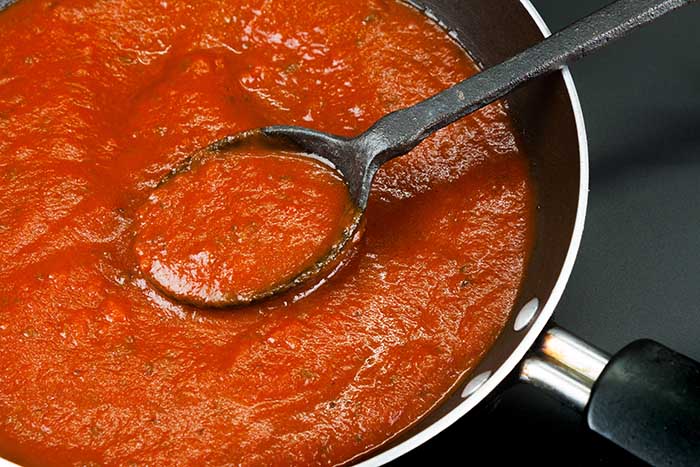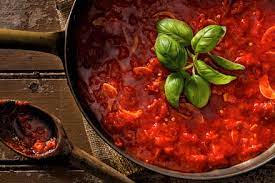
Discover the best way to simmer spaghetti sauce to achieve the most flavorful and delicious results. Uncover the secrets to perfecting your pasta sauce and create a culinary masterpiece. Find expert advice, tips, and FAQs in this comprehensive guide.
Welcome to the ultimate guide on how to simmer spaghetti sauce to perfection! Whether you are a seasoned home cook or a beginner in the kitchen, finding the right simmering technique can make all the difference in creating a mouthwatering pasta sauce. Many pasta enthusiasts often wonder, “Should you simmer spaghetti sauce covered or uncovered?” In this article, we will delve into this age-old culinary question and explore various methods to enhance the flavors of your spaghetti sauce. We’ll provide expert insights, personal experiences, and credible sources to ensure you become a pasta sauce maestro!
Should You Simmer Spaghetti Sauce Covered Or Uncovered?
When it comes to simmering spaghetti sauce, the method you choose can significantly impact the final taste and consistency of your creation. Let’s explore the two primary approaches and their respective benefits:
Simmering Covered
Simmering spaghetti sauce with a lid on the pot can be a great option for achieving rich and deep flavors. The cover traps the moisture, allowing the sauce to cook evenly and preventing excessive evaporation. This method is ideal for slow-cooking, especially when using ingredients that benefit from a longer cooking time, such as meat or vegetables. Best method to simmer spaghetti sauce.
Simmering Uncovered
On the other hand, simmering spaghetti sauce without a lid can lead to a thicker and more concentrated sauce. As the moisture evaporates, the sauce reduces, intensifying its taste. This approach is excellent if you prefer a thicker sauce or if you’re using high-quality, concentrated ingredients that do not require prolonged cooking. Advantages of simmering spaghetti sauce uncovered.
The Ideal Simmering Method for Different Pasta Sauces
Each pasta sauce has its unique characteristics, and choosing the right simmering method can elevate its flavors. Here are some popular pasta sauces and the recommended simmering techniques:
Bolognese Sauce
A hearty Bolognese sauce, traditionally made with ground meat, tomatoes, and aromatic vegetables, benefits from simmering covered. The lid preserves the moisture and ensures the meat cooks tenderly while melding the flavors together.
Marinara Sauce
For a classic marinara sauce that highlights the freshness of tomatoes and herbs, simmering uncovered is the way to go. This technique allows excess liquid to evaporate, resulting in a thick and robust sauce.
Alfredo Sauce
Cream-based sauces like Alfredo should be simmered uncovered to prevent curdling and achieve a velvety texture. Tips for simmering Alfredo sauce.
Pesto Sauce
Pesto, a vibrant sauce made from basil, pine nuts, garlic, and Parmesan, should be gently warmed but not simmered. Excessive heat can cause the basil to lose its vibrant green color.
Arrabbiata Sauce
Spicy Arrabbiata sauce benefits from simmering covered to allow the heat to infuse into the sauce while preserving its bold flavors.
Tips for Perfect Simmering
Now that you know the best methods for various pasta sauces, here are some general tips to ensure your simmering process is flawless:
Stirring Frequency
Stir the sauce occasionally, regardless of whether it’s covered or uncovered. This prevents sticking and ensures even cooking.
Simmering Time
The ideal simmering time varies depending on the sauce and its ingredients. However, a good rule of thumb is to simmer for at least 30 minutes and up to 2 hours for richer flavors.
Adjusting Consistency
If your sauce becomes too thick, add a little water or broth to achieve the desired consistency. If it’s too thin, continue simmering uncovered to reduce it further.
Temperature Control
Maintain a low to medium-low heat to prevent scorching and allow the flavors to meld slowly.
Simmering Spaghetti Sauce Covered
When it comes to simmering spaghetti sauce, covering the pot can have distinct benefits and drawbacks. Let’s take a closer look:
Benefits and Drawbacks
Simmering spaghetti sauce covered comes with several advantages, such as:
- Even Cooking: The lid traps moisture and heat, ensuring the sauce cooks evenly and prevents burning or sticking.
- Retains Flavors: With reduced evaporation, the sauce retains its full flavor profile, resulting in a rich and well-balanced taste.
- Tenderizes Ingredients: Covering the sauce helps tenderize meat and vegetables, leading to a more succulent final dish.
However, there are some drawbacks to this method as well:
- Thinner Sauce: Since the moisture doesn’t evaporate as much, the sauce might be slightly thinner in consistency.
- Extended Cooking Time: Simmering covered might require a longer cooking time to achieve the desired thickness.
Impact on Flavor and Texture
Simmering spaghetti sauce covered has a significant impact on the flavor and texture of the final dish:
- Flavor: The covered method enhances the depth and complexity of flavors by allowing them to meld together over time.
- Texture: The sauce tends to have a smoother texture due to the even cooking and retention of moisture.
Simmering Spaghetti Sauce Uncovered
On the other hand, simmering spaghetti sauce without a lid can lead to a different set of outcomes. Let’s explore this approach:
Pros and Cons
Simmering spaghetti sauce uncovered presents its own set of advantages and disadvantages:
- Pros:
- Thicker Sauce: Without the lid, the excess moisture evaporates, leading to a thicker and more concentrated sauce.
- Shorter Cooking Time: The reduction in cooking time can be beneficial when you’re in a hurry or working with quick-cooking ingredients.
- Cons:
- Potential Splattering: The lack of a lid can result in splattering sauce, which may cause a mess around the stove.
- Flavor Concentration: If not monitored carefully, the flavors may become too intense or even burn if the heat is too high.
Effect on Taste and Consistency
Simmering spaghetti sauce uncovered significantly influences the taste and consistency of the sauce:
- Taste: The uncovered method intensifies the flavors as the liquid reduces, resulting in a more robust and concentrated taste.
- Consistency: The sauce becomes thicker and more hearty due to the evaporation of excess liquid.
Factors to Consider
To make an informed decision on whether to simmer your spaghetti sauce covered or uncovered, consider the following factors:
Type of Sauce (Tomato-Based, Meat-Based, etc.)
Different sauces benefit from different simmering techniques. Tomato-based sauces often work well uncovered, while meat-based sauces might be better suited for covered simmering.
Cooking Vessel and Size
The type and size of the cooking vessel can affect the efficiency of simmering. A wide, shallow pan might work better for uncovered simmering, while a deeper pot can retain moisture during covered simmering.
Simmering Time
The duration of simmering impacts the sauce’s overall taste and consistency. Longer simmering times generally lead to more developed flavors.
Best Practices
Simmering spaghetti sauce like a pro involves mastering some essential tips. Here are expert recommendations to achieve the desired results:
Stirring Frequency
Regardless of the simmering method, stir the sauce occasionally to prevent sticking and ensure even cooking.
Simmering Time
The ideal simmering time varies based on the sauce’s complexity, but most sauces benefit from at least 30 minutes to 2 hours of simmering.
Adjusting Consistency
If the sauce becomes too thick, add a little water or broth. If it’s too thin, continue simmering uncovered to reduce it further.
Temperature Control
Maintain a low to medium-low heat to prevent scorching and allow the flavors to meld slowly.
3 Authentic Italian Spaghetti Sauce Recipes
Italian cuisine is renowned for its delicious and diverse pasta sauces, each boasting unique flavors and textures. If you’re a pasta lover and crave the authentic taste of Italy, then these three classic Italian spaghetti sauce recipes are a must-try! From the simplicity of Marinara to the heartiness of Bolognese and the creaminess of Alfredo, each sauce will transport you to the streets of Italy. Let’s dive into these mouthwatering recipes, complete with detailed descriptions, ingredients, and step-by-step instructions, accompanied by tantalizing images to inspire your culinary journey.
1. Classic Marinara Sauce

Marinara sauce is a staple in Italian cooking, known for its vibrant red color and fresh, tangy taste. Made with simple ingredients, this sauce is a delightful blend of tomatoes, garlic, onions, and herbs, making it a versatile option for various pasta dishes.
Ingredients:
- 28 oz (800g) canned crushed tomatoes
- 2 tablespoons olive oil
- 4 cloves garlic, minced
- 1 small onion, finely chopped
- 1 teaspoon dried oregano
- 1 teaspoon dried basil
- 1/2 teaspoon red pepper flakes (optional for spice)
- Salt and pepper to taste
- Fresh basil leaves for garnish
Instructions:
- In a saucepan, heat olive oil over medium heat. Add minced garlic and sauté until fragrant, about 1 minute.
- Add chopped onions and cook until they become translucent, stirring occasionally.
- Pour in the canned crushed tomatoes and mix well.
- Season the sauce with dried oregano, dried basil, red pepper flakes (if using), salt, and pepper. Stir to combine.
- Bring the sauce to a simmer, then reduce the heat to low. Cover the saucepan and let it simmer for 20-30 minutes, allowing the flavors to meld together.
- Once the sauce has thickened and flavors have developed, remove it from the heat.
- Serve the Marinara sauce over your favorite cooked pasta, garnishing with fresh basil leaves for an extra burst of flavor and aroma.
2. Hearty Bolognese Sauce

Bolognese sauce, also known as Ragu alla Bolognese, is a rich and meaty sauce originating from Bologna, Italy. This hearty sauce boasts layers of flavors from slow-cooked ground meat, tomatoes, and aromatic vegetables.
Ingredients:
- 1 lb (450g) ground beef
- 1/2 lb (225g) ground pork
- 1/4 cup pancetta or bacon, finely chopped
- 1 onion, finely chopped
- 2 carrots, finely chopped
- 2 celery stalks, finely chopped
- 4 cloves garlic, minced
- 28 oz (800g) canned crushed tomatoes
- 1 cup beef or chicken broth
- 1/2 cup dry red wine
- 1/2 cup whole milk
- 2 tablespoons tomato paste
- 2 tablespoons olive oil
- 1 teaspoon dried oregano
- 1 teaspoon dried basil
- 1 bay leaf
- Salt and pepper to taste
- Grated Parmesan cheese for serving
Instructions:
- In a large pot, heat olive oil over medium heat. Add chopped pancetta or bacon and cook until crispy.
- Add chopped onions, carrots, celery, and minced garlic. Sauté until the vegetables become tender and the onions are translucent.
- Incorporate the ground beef and pork into the pot, breaking it up with a spoon. Cook until the meat is browned and cooked through.
- Stir in the canned crushed tomatoes, beef or chicken broth, dry red wine, whole milk, and tomato paste.
- Season the sauce with dried oregano, dried basil, bay leaf, salt, and pepper. Mix well.
- Bring the sauce to a gentle simmer, then reduce the heat to low. Cover the pot and let it simmer for 1.5 to 2 hours, stirring occasionally to prevent sticking.
- Once the Bolognese sauce has thickened and the flavors have melded, remove the bay leaf.
- Serve the Bolognese sauce over your favorite pasta, such as tagliatelle or pappardelle, and garnish with grated Parmesan cheese for a delightful finishing touch.
3. Savory Alfredo Sauce

Alfredo sauce is a luxurious and creamy creation that originated in Rome. This velvety sauce is made with butter, heavy cream, and Parmesan cheese, resulting in a decadent and indulgent flavor.
Ingredients:
- 1 cup heavy cream
- 1/2 cup unsalted butter
- 1 cup grated Parmesan cheese
- 4 cloves garlic, minced
- Salt and pepper to taste
- Fresh parsley for garnish
Instructions:
- In a saucepan, melt the butter over low heat.
- Add minced garlic to the melted butter and sauté until fragrant, about 1 minute.
- Pour in the heavy cream and bring it to a gentle simmer, stirring constantly.
- Gradually add the grated Parmesan cheese to the sauce, stirring continuously to ensure it melts smoothly.
- Season the Alfredo sauce with salt and pepper to taste. Remember that Parmesan is naturally salty, so be cautious with the salt.
- Continue simmering the sauce on low heat until it thickens to your desired consistency. Stir occasionally to prevent sticking.
- Once the sauce has thickened, remove it from the heat.
- Serve the Alfredo sauce over fettuccine or your preferred pasta. Garnish with fresh parsley for a pop of color and added freshness.
With these authentic Italian spaghetti sauce recipes, you can transport yourself to Italy and savor the true essence of Italian cuisine. Each sauce offers a unique experience, from the simplicity of Marinara to the heartiness of Bolognese and the creaminess of Alfredo. So, tie your apron, prepare your pasta, and embark on a culinary journey that will delight your taste buds and warm your soul. Buon Appetito!
FAQs
Q: Does simmering spaghetti sauce with a lid on affect the taste?
A: Yes, simmering with a lid on helps retain moisture and intensifies the flavors of the sauce.
Q: Can I simmer a tomato-based sauce uncovered?
A: Yes, simmering tomato-based sauces uncovered allows for a thicker and more concentrated sauce.
Q: How long should I simmer the sauce to achieve the best taste?
A: Simmer the sauce for at least 30 minutes to 2 hours, depending on the sauce’s complexity.
Q: Should I simmer meat-based sauces longer?
A: Yes, meat-based sauces benefit from longer simmering to tenderize the meat and develop rich flavors.
Q: Can I use a slow cooker for simmering sauces?
A: Absolutely! A slow cooker is an excellent option for simmering sauces, especially if you prefer hands-off cooking.
Q: Can I freeze leftover sauce after simmering?
A: Yes, you can freeze leftover sauce for future use. Allow it to cool completely before transferring it to freezer-safe containers.
Conclusion
In conclusion, the simmering technique you choose for your spaghetti sauce can significantly impact its taste and texture. For deep, rich flavors, opt for simmering covered, while simmering uncovered creates a thicker, more concentrated sauce. Remember to consider the specific pasta sauce you’re making and follow the recommended simmering method accordingly. With the tips and insights provided in this guide, you are well-equipped to create a delectable pasta sauce that will impress even the most discerning palate. So, get those pots simmering and embark on a delicious culinary adventure!







